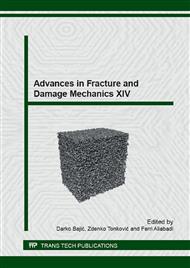p.5
p.9
p.13
p.17
p.21
p.25
p.29
p.33
p.37
Ductility of Ultra-High Performance Concrete and its Correlation with Tensile Strength Increase
Abstract:
In this study, ductility of members with ultra-high performance concrete was investigated using moment-curvature analysis for the verification of safety under large deformation of ultra-high performance concrete structural members. For the analysis of members with ultra-high performance concrete, mathematical stress-strain model was selected among the results conducted by other researchers on the compressive and tensile behavior of high strength concrete and fiber reinforced concrete. According to the investigation on ductility of members with ultra-high performance concrete, decrease of ductility was observed with increase of tensile strength of concrete under the same reinforcement ratio. Members with 2~3% of reinforcement ratio, which usually be used in the field engineering, show the decrease of ductility with increase of fiber volume fraction. As a results of parametric study, limitation of maximum reinforcement ratio ( or limitation of net tensile strain ) suggested by current design code is not safe when using ultra-high performance concrete.
Info:
Periodical:
Pages:
21-24
Citation:
Online since:
September 2015
Authors:
Price:
Сopyright:
© 2016 Trans Tech Publications Ltd. All Rights Reserved
Share:
Citation:


